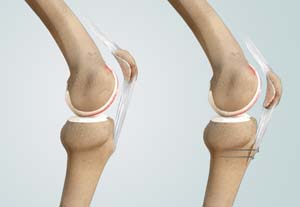
Anatomy of the Tibial Tubercle
The tibial tubercle is a bony lump on the tibia (bone in the lower leg) below the kneecap. This serves as an attachment point for the patellar ligaments, tendons, and muscles.
What is Distal Realignment?
Distal realignment procedures, also known as tibial tubercle transfer (TTT) procedures, are performed to reposition the kneecap after subluxation or dislocation by realigning the tendon under the kneecap to the underlying tibial tubercle.
Distal Realignment Procedure
The distal realignment procedures include:
- Maquet procedure: In this procedure, the tibial tubercle is cut, keeping the patellar tendon attachment intact. The tubercle is elevated by wedging the loosened piece of bone using a bone block. This procedure cannot move the tendon and tubercle medially (towards the inner aspect of the knee).
- Elmslie-Trillat procedure: This is a procedure similar to the Maquet procedure, except that the tendon and tubercle can be moved medially.
- Fulkerson procedure: In this procedure, the tibial tubercle is moved more towards the inner aspect of the knee. This is achieved by breaking the bone into sharp pieces (splintered), allowing the bits of bone and tendon to move more medially. After the procedure, the bits of bone are held in place using screws.
- Hauser procedure: In this procedure, the tibial tubercle is moved medially, but not moved forward (anterior). Because of the shape of the tibia, the tubercle may shift its position more posteriorly (behind) and the patella may press down, causing pain.
- Roux-Goldthwait procedure: It is a distal realignment procedure where the patellar tendon is split vertically. The lateral half of the patellar tendon is pulled under the inner half (medial) and attached to the tibia. This pulls the patella over to the center and helps prevent excess lateral shift.
Related Topics:
- Knee Arthroscopy
- ACL Reconstruction
- Multiligament Reconstruction of the Knee
- Meniscal Surgery
- Cartilage Restoration
- Orthobiologics
- ACL Reconstruction with Patellar Tendon
- Partial Arthroscopic Meniscectomy
- Saucerization
- Intraarticluar Knee Injection
- Knee Fracture Surgery
- Arthroscopic Debridement
- LPFL Reconstruction
- Tibial Derotational Osteotomy
- Failed Meniscus Repair
- Meniscal Transplantation
- Meniscectomy
- Mosaicplasty
- Posterolateral Corner Reconstruction
- Prior Meniscectomy
- Quadriceps Tendon Repair
- Tibial Eminence Fracture
- Trochleoplasty
- ORIF of the Knee Fracture
- Chondroplasty
- Distal Femoral Osteotomy
- Hamstring Autograft
- Hamstring Allograft
- Viscosupplementation
- Physical Therapy for Knee
- Knee Osteoarthritis
- High Tibial Osteotomy
- Tibial Tubercle Osteotomy
- Patellar Tendon Repair
- Robotic Assisted Partial Knee Surgery
- Distal Realignment Procedures
- PCL Reconstruction
- LCL Reconstruction
- MCL Reconstruction
- Cartilage Replacement
- Bicompartmental Knee Resurfacing
- Autologous Chondrocyte Implantation
- Subchondroplasty
- Partial Meniscectomy
- Transphyseal Surgery
- Partial Transphyseal Surgery
- Medial Patellofemoral Ligament Reconstruction
- ACL Reconstruction Procedure with Hamstring Tendon
- Physeal Sparing Surgery (Anderson's Technique)
- Physeal Sparing Surgery (Micheli-KocherTechnique)
- Combined Hyaluronic Therapy for the Knee
- Matrix Induced Autologous Chondrocyte Implantation (MACI)
- Failed Anterior Cruciate Ligament (ACL) Reconstruction
- Physeal Sparing Reconstruction of the Anterior Cruciate Ligament
- Bone-Patellar Tendon-Bone (BPTB) Autograft
- Bone-Patellar Tendon-Bone (BPTB) Allograft
- Pharmacological Interventions for Knee Injuries
- Arthroscopic Reconstruction of the Knee for Ligament Injuries

